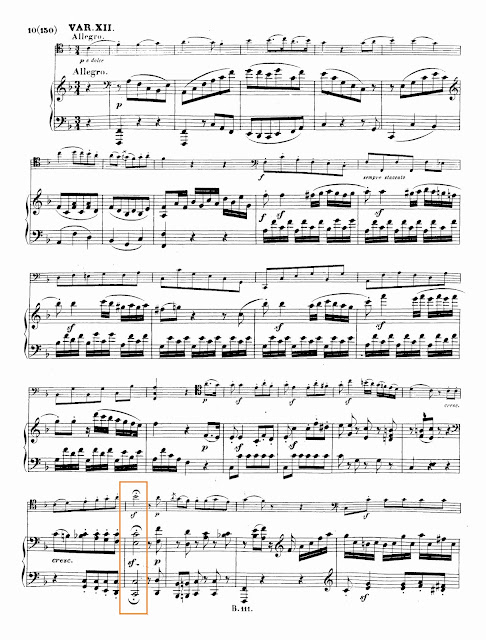CCCXCV. BEETHOVEN, Ludwig van (1770-1827)
One cannot help cracking a smile, thinking of poor Papageno's aria, where he pleads for a girlfriend -- or even a wife?!
Beethoven's output for the cello/piano combo yielded five sonatas, and three sets of variations (see Post CLXVIII for the Handel variations).
The first two sonatas and all three variations date from this early period. The third sonata is from 1807-8 and the final two from 1815.
The Theme & Variations form is a perfect way for a composer to spin a few simple phrases into something which can stand alone as a unique piece of music (see The Diabelli Variations, for example: Post CCXXXVII).
The young Beethoven obviously thought the simple I/V melody was worth twisting about:
Theme
Variation I
The cello is tacet while the piano spins out a series of consecutive two-16th-note motifs, and ending with a cadenza-like flourish after the V7 chord (which is held in every variation) near the end.
Variation II
After having distorted the theme so drastically, Beethoven returns to its plain outline, with the cello in its treble clef range:
Variation III
The cello part is relatively simple (this is true of the entire set). The pianist, however, must negotiate a cascading torrent of 32nd-notes throughout the entire variation:
Variation IV
The cello opens with some rich double-stops; the piano again plays the two-16th-note motif, with the cello -- again in the treble clef range -- plays a few interrupted phrases:
Variation V
Like a French dance, with its dotted-16th/32nd rhythm, Beethoven decorates the them lavishly:
Variation VI
Again, Beethoven uses fast, triadic 32nd-notes -- this time in the right hand -- and adds a few sforzandi to great effect:
Variation VII
Again, another little mini-cadenza following the fermata:
Variation VIII
Staccato:
Variation IX
Beginning with an unstable off-beat, Beethoven builds up to a ff climax on the held C7 chord -- then ends everything with a hush!
Variation X
The next two variations are in F Minor!
Double-dotted 1/8th-32nd motif. Gravitas!
Variation XI
Still in the minor, Beethoven introduces triplet accompaniment. Another post-fermata flourish, and he whispers out the ending, preparing the final variation:
Variation XII


























No comments:
Post a Comment